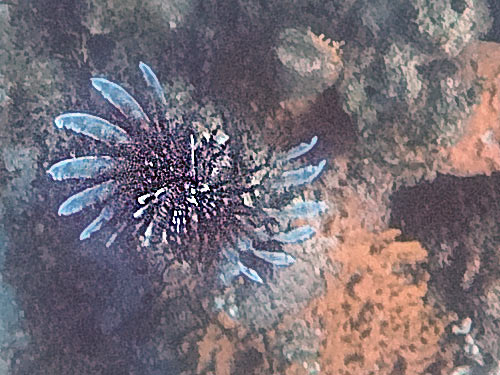About lobsters and Lionfish
The Caribbean islands would not be half as beautiful without the sea surrounding them. Well, apart from that, they wouldn’t be islands without the sea.
The oceans are huge hunting grounds. Not a day goes by without fish leaping metres past to get to safety from larger hunters. Frigate birds and pelicans plunge into the water right next to our boat to reappear with fish in their beaks. It doesn’t matter if we swim two metres away.
Even though we don’t hunt so elegantly, we also take part in the hunt for sea food. On the way out to sea, we cast our lines and hope for mahi-mahi, wahu or tuna. We especially like Portuguese mackerel which is rarely cooperative.
We only catch as much as we can eat. And at most every 4-5 attempts are successful, with a downward trend. Most of the time, sargassum grass ruins our food. Thick ochre-coloured carpets of this floating grass get tangled in the bait and even the dumbest fish notices that there might be something wrong with the bait on offer. But it’s a perfect aerobic arm workout to reel in the sargassum-covered lures with 200 metres of line.

Sargassum gras makes fishing impossible
But every now and then a bite works out and after we’ve done the (literally) bloody business of cutting them up, we’re delighted with a wide range of food from sashimi to grilled fish. But I have to admit that it also took a lot of time and expenses until our success rate increased. The fishing equipment on our first trip turned out to be pitiful. Today our grandson uses it as a play fishing rod. For this trip we bought two really neat pieces of equipment from a fishing shop in Tenerife, with a deterrent effect on our potential prey and a celebration for the dealer.
Lobster hunting
Our learning curve is incomparably flat when it comes to our favourite prey: lobsters. There, too, we try to practice sportsmanship and hunt only with a lobster snare. This is a metal loop attached to the tip of a stick that tightens when pulled. The theory is that you should pull the loop over the animal’s tail from behind, then tighten it with a jolt and have the tasty morsel on the line.
Only we either don’t get anything around the tail or the potential victim shoot off like rockets. Or just before they get a hold, we have to surface because we’re running out of air. We caught a dwarf once, but let him go straight away. He could barely swim. I’m pretty sure I’ve seen Lobster laugh when we’ve gone off without doing anything. Maybe it saves our honour a little that we’re more into langoustines at the moment and they’re really tiny.


Hunting with Lobster sling
The advantage of the lobster snare is – or rather would be – that you can examine the caught animal alive to see if it is a female and egg-bearing. In that case, the cultivated hunter should release the prey again to let the next generations grow up. I find it decadent to hunt lobsters with a harpoon or spear, because it is quite difficult to release a dead animal.
We seem to be crowning our efforts to hunt sustainably. Not only do we not catch females, we don’t catch any lobsters at all. It doesn’t get any more population-friendly than that. Our skills need urgent improvement. Out of desperation, we will soon be watching YouTube videos on the subject.
The Plague of Lionfish
We will get a harpoon after all, but only to wipe out fish. Hopefully sustainably too. Lionfish are getting an unpleasant issue in the oceans. These fish are visually spectacular creatures that could have been created by a Parisian fashion designer. Colourful, with feathers and lots of bells and whistles.




Photos: National Geographics and we
They originated in the Pacific and nobody was bothered by them there because they had predators and everything stayed in balance. Then they were probably brought to the Caribbean by a freighter in a ballast water tank. Here, nobody knew them and therefore they had no natural enemies. They were able to spread undisturbed and do so at a masterly speed. Lionfish have the unappealing habit of devouring everything small fish and crustaceans that get in their way. The result is an epidemic-like spread and an existential threat to many species.
They are now seen all over the Caribbean and the chances of stopping the invasion are not good. Some marine biologists are training potential predators to eat these invaders, such as sharks. But this is tedious and takes time, because sharks are not the smartest on the fish shelf. On some islands, where spear fishing and harpooning is normally prohibited, hunting Lionfish is explicitly allowed and encouraged. And that’s where we come in, with hopefully another good learning curve.
To draw attention to the problem, a cooking competition was held at the last Americas Cup. The chefs of the teams competed for the best Lionfish dish. These fish taste very good, but the preparation is not easy. They have poisonous stingers and the poison can also be dangerous for humans. Therefore, the preparation is not trivial. “Eat more lionfish” is the good resolution for the New Year.
Lionfish have also arrived in the Mediterranean and are plying their nasty trade there. So if you see a feather-clad fish beauty on your next holiday, be aware, this creature is a killer and should definitely go into a sizzling pan.
We will soon be walking the fine line of considerate ocean users and reckless Lionfish killers. Hopefully our Lionfish hunt will be more successful than our Lobster stalk. /Holger Binz
*Photos: some of the photos used are from Patrick, National Geographics

